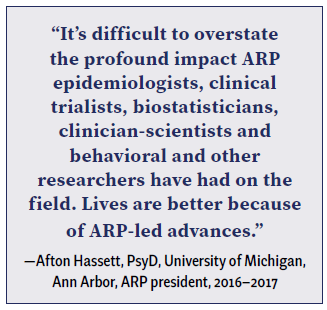The ARP continues work with the ACR to creatively address workforce changes through the use of telehealth, artificial intelligence and alternative healthcare delivery models. The ACR and the Foundation are focused on the big workforce challenges that lie ahead. The ARP is part of the solution and eager to participate in that planning.
Building the Evidence Base to Guide Practice
The impressive changes to practice over the years were greatly influenced by the expansion of research conducted by ARP professionals and the development of a supporting research infrastructure. Initially, clinical practice evolved from collective clinical wisdom passed down from more experienced clinicians, or from mentor to mentee. Carolee Moncur, PhD, PT, the ARP president in 1992, captured this in her seminal article, “Attacking the Sacred Cows,” in which she summarized the state of our science as based on “early research, a small number of subjects and anecdotal experience.”8
The landscape for rheumatology changed dramatically in the late 1970s and 1980s, the halcyon days for rheumatology research. National Institutes of Health-funded Multipurpose Arthritis Centers attracted numerous health professional researchers into the field, who began to establish the evidence base for physical activity, self-management education and therapeutic modalities. Other agencies and nonprofit organizations also funded rheumatology-related research. Paradigm-shifting articles, such as Minor’s publication on aerobic exercise and Lorig’s work on self-management education, were published in this era and fundamentally altered the course of rheumatology care.9,10
As research expanded, it significantly influenced rheumatology practice. By the mid-1980s, the ARP recognized the need for a dedicated, central platform to publish this important research. In response, the ARP launched the interdisciplinary journal Arthritis Care & Research (AC&R) in 1988, which now ranks in the top quarter of rheumatology journals worldwide.
Moncur’s article attacking the sacred cows was published in the first issue of AC&R. In 1994, she published a second article, titled “Re-visiting the Sacred Cows,” in a special issue of AC&R on exercise and arthritis.11 Her first article summarized the limited scientific evidence supporting various exercise recommendations for rheumatology patients. The follow-up article highlighted new research conducted during the intervening seven years and concluded that recommendations were now based on appropriately asked questions and well-designed investigations, not sacred cows. This evidence trend continues to grow and influence our ever-improving practice.
Currently, both challenges and opportunities exist for research. Research performed by health professionals is well regarded, research mentorship continues, and federal funding agencies are including more rheumatology researchers as reviewers on review panels. However, federal funding for rheumatology professional research is significantly reduced from those halcyon days, making it more competitive to get funded. Fortunately, the Foundation has stepped into this void, dramatically increasing funding for ARP-relevant research and education over the past decade, and it continues to expand its funding portfolio.12




